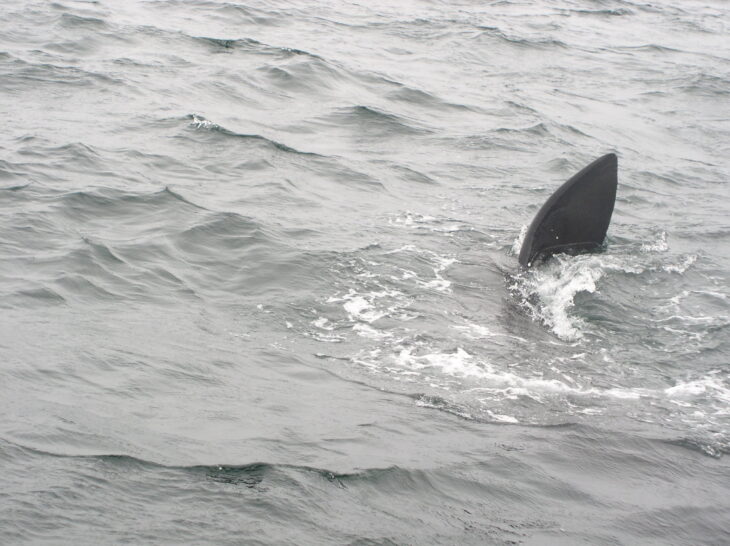Satellites and basking sharks
Returning from a Seasearch diving survey in July 2006, I had the privilege of encountering a basking shark feeding off the north coast of the Isle of Rum. Witnessing first-hand one of these gentle giants effortlessly carving through cold Hebridean waters whilst feeding on some of the smallest animals in the sea, made tangible their immense power and bulk. But it also brought home their vulnerability to potential threats such as boat traffic, entanglement in fishing gear and microplastics.

Every summer, basking sharks congregate in their hundreds in the rich waters of the Sea of the Hebrides to feed on tiny animal plankton including shrimp-like copepods, eggs and larvae. Deep, cool waters full of nutrients mix with warmer surface waters creating an area of high productivity known as a ‘tidal front’. But where do these sharks spend the winter?
In the summer months of 2012, 2013 and 2014, the University of Exeter and Scottish Natural Heritage (SNH) set about trying to find the answer. Thanks to advice and equipment provided by Jackie and Graham Hall of Manx Wildlife Trust (Manx Basking Shark Watch), Dr Matthew Witt and his team from the University of Exeter managed to tag 61 basking sharks. This involved attaching a satellite tag to the base of each shark’s dorsal fin – something that is far easier said (or indeed written) than done. Once tagged, every time a shark came to the surface to feed, its tag would break the surface of the water and transmit the location of the shark via satellite, allowing the team to track each shark as it went about its day-to-day movements.
In 2016, when the plan to tag in Cornish waters was shelved due to such low numbers visiting there, the Marine Conservation Society (MCS) collaborated with the University of Exeter and SNH to tag more Hebridean basking sharks. This time, three towed satellite tags were attached to sharks in Gunna Sound between the islands of Coll and Tiree, a hotspot already identified by the work of Dr Colin Speedie and The Wildlife Trusts.
In early August 2018, the University of Exeter and SNH teamed up once again to tag three more basking sharks in the Sea of the Hebrides. These sharks were tagged with towed camera tags, previously used on manta rays but a first for this species. The enthralling video footage that was captured revealed behaviours that had never been seen before including sharks potentially forming social groups and aggregating near the seabed.
As a result of this tagging study – the first in the world to use such a range of technologies – we now know that the basking sharks feeding in Scotland’s seas migrate in winter to deeper waters, some staying relatively close but others travelling further afield to the west of Ireland, Spain and Portugal. One shark even travelled as far south as the Canary Islands. As long suspected, tagging has now proven that many individuals return to feed each summer in Hebridean seas.
Crucially, the tagging data also confirmed that basking sharks stayed largely within the Sea of the Hebrides from July through to September. This complemented citizen science sightings collected by MCS and the Hebridean Whale and Dolphin Trust, and underlined the importance of this area for basking sharks every summer.
This important evidence base has contributed significantly to the Sea of the Hebrides being proposed as a Marine Protected Area (MPA). The annual gathering of basking sharks, as well as other marine species such as minke whales that come to the area to feed, makes this one of Scotland’s most important marine wildlife sites.
You can show your support for this and three other proposed Scottish MPAs by visiting baskingsharkmpa.co.uk by 30 August. Once formally recognised as an MPA, management measures can be implemented to ensure the Sea of the Hebrides remains a global safe haven for these giant ocean wanderers.
Calum Duncan
Head of Conservation Scotland
Marine Conservation Society
Help protect Scotland’s wildlife
Our work to save Scotland’s wildlife is made possible thanks to the generosity of our members and supporters.
Join today from just £3 a month to help protect the species you love.
Preface
Returning from a Seasearch diving survey in July 2006, I had the privilege of encountering a basking shark feeding off the north coast of the Isle of Rum. Witnessing first-hand …
